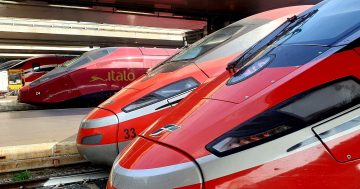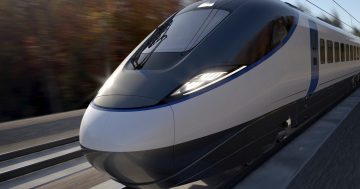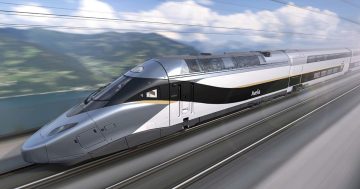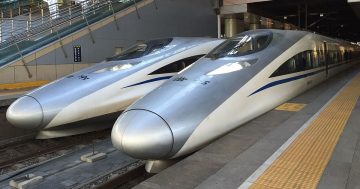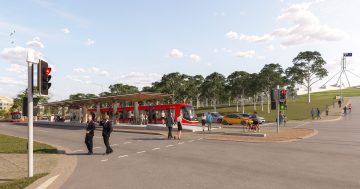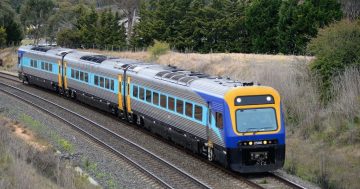
Now the election is over, it’s time for all the unresolved detail for the light rail to be handed over to Capital Metro. That will leave space for the ACT Government to look at other ways transport infrastructure can be developed for Canberra with the few meagre dollars that are left in the Territory coffers.
As well as getting people around the territory, attention needs to be paid to Canberra’s relative isolation and how commuting times between Sydney and Melbourne can be improved. This turns our attention to the long discussed and unresolved subject of a high speed rail (HSR) that can potentially link Canberra with Sydney in one hour and Melbourne in three hours.
In an election campaign more or less dominated by just one part of the overall Canberra transport equation, it is not surprising that many voters missed an important update on Consolidated Land and Rail Australia (CLARA). It threw its cards on the table and gave details of their proposed route between Sydney and Melbourne. And it could cost the ratepayers of Canberra nothing and at the same time reap a range of economic benefits for the region.

The CLARA map shows the proposed route of the rail track passes tantalisingly close to Canberra, but not through Canberra, with a proposed spur line shown as a dotted line. There is a similar spur line linking the main line with both Wagga Wagga and Albury.
As part of their recent election campaign which included a strong push for a bullet train link, my Like Canberra Party colleague Tim Bohm contacted Consolidated Land and Rail Australia (CLARA) to get an update on the CLARA plan and progress with the governments and regional councils that are involved.
Mr Bohm was aware many voters were very keen to hear about a possible HSR and were well acquainted with the numerous benefits of HSR including the long-term economic dividends to cities along its route, workforce mobility, productivity gain and as a safe alternative to flying and travelling by car on increasingly busy highways. And, of course, there is the environmental aspect, with greenhouse gas emissions savings and lower pollution. Canberra had been suggested as part of the future in Phase Four, but Nick Cleary, CEO of CLARA, provided a welcome update and said there had been a change, and Canberra could be included in Phase One.
So, this visionary transport infrastructure program looks set to start sooner rather than later and with some swift footwork, Canberra could be part of Phase One. Land has already been purchased near Yass to be included in Phase One.
Nick Cleary confirmed he had approached and had positive conversations with all the relevant Governments, as well as relevant regional councils including Goulburn and Yass. The ACT Government was the only government which had not approached CLARA for any clarification of its intentions.*
So why wouldn’t the ACT Government have leapt in and embraced the very real possibility of HSR? It is possible there was a breakdown in communication. Chief Minister Barr had said that he wasn’t interested in CLARA as Canberra was on a branch line, and passengers would have to change at Yass. In the past few days, Nick Cleary has again confirmed that the spur line from the main line into Canberra will be direct and passengers will not have to change at Yass.
So back to how this project will actually be funded. CLARA isn’t pussyfooting around about where the money is coming from. The CLARA HSR project provides a vision to connect the east coast of Australia with eight new regional cities. It is a major venture that involves making money out of selling land and building houses to make a profit to fund infrastructure.
One would have thought Andrew Barr would have been quite comfortable with this model. So, will Canberra be passed by, or will Mr Barr start negotiating on behalf of the citizens of Canberra? There is no doubting the benefits of HSR: opening up economic and tourism opportunities; allowing entrepreneurs to move freely; and get people out of their cars and onto public transport.
If the ACT Government wants to make a big impact in the future, it needs to act now to ensure that Canberra is connected, Canberra is smart and Canberra leads the way in innovation for its citizens. To do this, we need the ACT Government to do everything it can to assist CLARA to secure the 12km alignment and corridor to the Canberra International Airport.
If the ACT Government chooses to sit on its hands and wait for another opportunity to fall out of the sky, will we be in the same situation in ten year’s time with only ever slower car, coach or flight options to transfer interstate. Either Canberra can remain a relatively marooned big country town, or it can take a leading role with this exciting initiative.
What are we waiting for? Check out what CLARA has planned for the future of Australia and what Canberra could miss out being part of at www.clara.com.au.
Maryann Mussared was a candidate for the Like Canberra Party, formerly known as the Bullet Train for Canberra Party, at the recent ACT election.
* Editor’s note: We contacted Mr Barr’s office for his response to Ms Mussared’s comments and have added his reply in the comments below. We have also contacted Canberra Airport about the issue and will update readers on their response when it comes to hand.












